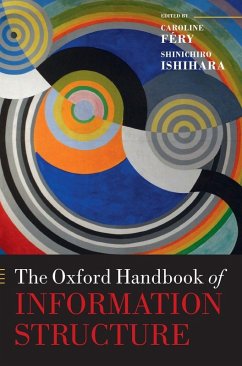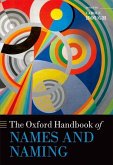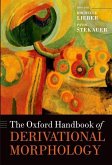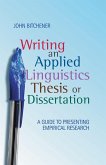- Gebundenes Buch
- Merkliste
- Auf die Merkliste
- Bewerten Bewerten
- Teilen
- Produkt teilen
- Produkterinnerung
- Produkterinnerung
This book provides linguists with a clear, critical, and comprehensive overview of theoretical and experimental work on information structure. Leading researchers survey the main theories of information structure in syntax, phonology, and semantics as well as perspectives from psycholinguistics and other relevant fields. Following the editors' introduction the book is divided into four parts. The first, on theories of and theoretical perspectives on information structure, includes chapters on topic, prosody, and implicature. Part 2 covers a range of current issues in the field, including…mehr
Andere Kunden interessierten sich auch für
![OHB NAMES & NAMING OHBK C OHB NAMES & NAMING OHBK C]() HoughOHB NAMES & NAMING OHBK C193,99 €
HoughOHB NAMES & NAMING OHBK C193,99 €![OHB LINGUISTIC TYPOLOGY OHBK C OHB LINGUISTIC TYPOLOGY OHBK C]() SongOHB LINGUISTIC TYPOLOGY OHBK C212,99 €
SongOHB LINGUISTIC TYPOLOGY OHBK C212,99 €![Oxford Handbook of Derivational Morphology Oxford Handbook of Derivational Morphology]() Oxford Handbook of Derivational Morphology212,99 €
Oxford Handbook of Derivational Morphology212,99 €![The Oxford Handbook of the History of English The Oxford Handbook of the History of English]() The Oxford Handbook of the History of English190,99 €
The Oxford Handbook of the History of English190,99 €![The Oxford Guide to the Romance Languages The Oxford Guide to the Romance Languages]() The Oxford Guide to the Romance Languages259,99 €
The Oxford Guide to the Romance Languages259,99 €![A Functional Discourse Grammar for English A Functional Discourse Grammar for English]() Evelien KeizerA Functional Discourse Grammar for English56,99 €
Evelien KeizerA Functional Discourse Grammar for English56,99 €![Writing an Applied Linguistics Thesis or Dissertation Writing an Applied Linguistics Thesis or Dissertation]() John BitchenerWriting an Applied Linguistics Thesis or Dissertation45,99 €
John BitchenerWriting an Applied Linguistics Thesis or Dissertation45,99 €-
-
-
This book provides linguists with a clear, critical, and comprehensive overview of theoretical and experimental work on information structure. Leading researchers survey the main theories of information structure in syntax, phonology, and semantics as well as perspectives from psycholinguistics and other relevant fields. Following the editors' introduction the book is divided into four parts. The first, on theories of and theoretical perspectives on information
structure, includes chapters on topic, prosody, and implicature. Part 2 covers a range of current issues in the field, including focus, quantification, and sign languages, while Part 3 is concerned with experimental approaches to information structure, including processes involved in its acquisition and
comprehension. The final part contains a series of linguistic case studies drawn from a wide variety of the world's language families. This volume will be the standard guide to current work in information structure and a major point of departure for future research.
structure, includes chapters on topic, prosody, and implicature. Part 2 covers a range of current issues in the field, including focus, quantification, and sign languages, while Part 3 is concerned with experimental approaches to information structure, including processes involved in its acquisition and
comprehension. The final part contains a series of linguistic case studies drawn from a wide variety of the world's language families. This volume will be the standard guide to current work in information structure and a major point of departure for future research.
Produktdetails
- Produktdetails
- Oxford Handbooks in Linguistics
- Verlag: OUP Oxford / Oxford University Press
- Seitenzahl: 994
- Erscheinungstermin: 28. Juli 2016
- Englisch
- Abmessung: 250mm x 175mm x 57mm
- Gewicht: 1857g
- ISBN-13: 9780199642670
- ISBN-10: 0199642672
- Artikelnr.: 44471607
- Herstellerkennzeichnung
- Libri GmbH
- Europaallee 1
- 36244 Bad Hersfeld
- gpsr@libri.de
- Oxford Handbooks in Linguistics
- Verlag: OUP Oxford / Oxford University Press
- Seitenzahl: 994
- Erscheinungstermin: 28. Juli 2016
- Englisch
- Abmessung: 250mm x 175mm x 57mm
- Gewicht: 1857g
- ISBN-13: 9780199642670
- ISBN-10: 0199642672
- Artikelnr.: 44471607
- Herstellerkennzeichnung
- Libri GmbH
- Europaallee 1
- 36244 Bad Hersfeld
- gpsr@libri.de
Caroline Féry is a Professor of Phonology at the Goethe University Frankfurt. Her research is in phonology and theory of grammar with a special focus on intonation and prosody, as well as the interface with information structure. She is the author of articles in journals such as Natural Language and Linguistic Theory, Lingua, and The Linguistic Review, and is co-editor, with Malte Zimmermann, of Information Structure: Theoretical, Typological, and Experimental Perspectives (OUP, 2010). Shinichiro Ishihara is Senior Lecturer at the Centre for Languages and Literature at Lund University, having previously held positions at Goethe University Frankfurt, the University of Stuttgart, and the University of Potsdam. His research focuses on the syntax-prosody interface and its relation to information structure in Japanese and other languages. His work has appeared in international journals such as Lingua and Syntax and in edited volumes published by OUP and Mouton de Gruyter.
* 1: Caroline Féry and Shinichiro Ishihara: Introduction
* Part I: Theories of Information Structure
* 2: Mats Rooth: Alternative semantics
* 3: Michael Rochemont: Givenness
* 4: Daniel Büring: (Contrastive) topic
* 5: Leah Velleman and David Beaver: Question-based models of
information structure
* 6: Laurence Horn: Information structure and the landscape of (non-)
at-issue meaning
* 7: Kjell Johan Sæbø: Information structure and presupposition
* 8: Enoch O. Aboh: Information structure: A cartographic perspective
* 9: Maria Luisa Zubizarreta: Nuclear stress and information structure
* 10: Karlos Arregi: Focus projection theories
* 11: Vieri Samek-Lodovici: Constraint conflict and information
structure
* Part II: Current Issues in Information Structure
* 12: Sigrid Beck: Focus sensitive operators
* 13: Manfred Krifka: Quantification and information structure
* 14: Sophie Repp: Contrast: Dissecting an elusive
information-structural notion and its role in grammar
* 15: Horst Lohnstein: Verum focus
* 16: Malte Zimmermann: Predicate focus
* 17: Patrick G. Grosz: Information structure and discourse particles
* 18: Susanne Winkler: Ellipsis and information structure
* 19: Ad Neeleman and Hans van de Koot: Word order and information
structure
* 20: Luis López: Dislocations and information structure
* 21: Balázs Surányi: Discourse-configurationality
* 22: Sara Myrberg and Tomas Riad: On the expression of focs in the
metrical grid and in the prosodic hierarchy
* 23: Hubert Truckenbrodt: Focus, intonation, and tonal height
* 24: Stefan Baumann: Second occurrence focus
* 25: Regine Eckardt and Augustin Speyer: Information structure and
language change
* Part III: Experimental Approaches to Information Structure
* 26: Elsi Kaiser: Information structure and language comprehension:
Insights from psycholinguistics
* 27: Michael Wagner: Information structure and production planning
* 28: Barbara Höhle, Frauke Berger, and Antje Sauermann: Information
structure in first language acquisition
* 29: Ina Bornkessel-Schlesewsky and Petra B. Schumacher: Towards a
neurobiology of information structure
* 30: Anke Lüdeling, Julia Ritz, Manfred Stede, and Amir Zeldes: Corpus
linguistics and information structure research
* Part IV: Language Studies on Information Structure
* 31: Gisbert Fanselow: Syntactic and prosodic reflexes of information
structure in Germanic
* 32: Cecilia Poletto and Giuliano Bocci: Syntactic and prosodic
effects of information structure in Romance
* 33: Katalin É. Kiss: Discourse functions: The case of Hungarian
* 34: Stavros Skopeteas: Information structure in Modern Greek
* 35: Katja Jasinskaya: Information structure in Slavic
* 36: Yiya Chen, Peppina Po-lun Lee, and Haihua Pa: Topic and focus
marking in Chinese
* 37: Satoshi Tomioka: Information structure in Japanese
* 38: Alexis Michaud and Marc Brunelle: Information structure in Asia:
Yongning Na (Sino-Tibetan) and Vietnamese (Austroasiatic)
* 39: Laura Downing and Larry M. Hyman: Information structure in Bantu
* 40: Vadim Kimmelman and Roland Pfau: Information structure in sign
languages
* References
* Index
* Part I: Theories of Information Structure
* 2: Mats Rooth: Alternative semantics
* 3: Michael Rochemont: Givenness
* 4: Daniel Büring: (Contrastive) topic
* 5: Leah Velleman and David Beaver: Question-based models of
information structure
* 6: Laurence Horn: Information structure and the landscape of (non-)
at-issue meaning
* 7: Kjell Johan Sæbø: Information structure and presupposition
* 8: Enoch O. Aboh: Information structure: A cartographic perspective
* 9: Maria Luisa Zubizarreta: Nuclear stress and information structure
* 10: Karlos Arregi: Focus projection theories
* 11: Vieri Samek-Lodovici: Constraint conflict and information
structure
* Part II: Current Issues in Information Structure
* 12: Sigrid Beck: Focus sensitive operators
* 13: Manfred Krifka: Quantification and information structure
* 14: Sophie Repp: Contrast: Dissecting an elusive
information-structural notion and its role in grammar
* 15: Horst Lohnstein: Verum focus
* 16: Malte Zimmermann: Predicate focus
* 17: Patrick G. Grosz: Information structure and discourse particles
* 18: Susanne Winkler: Ellipsis and information structure
* 19: Ad Neeleman and Hans van de Koot: Word order and information
structure
* 20: Luis López: Dislocations and information structure
* 21: Balázs Surányi: Discourse-configurationality
* 22: Sara Myrberg and Tomas Riad: On the expression of focs in the
metrical grid and in the prosodic hierarchy
* 23: Hubert Truckenbrodt: Focus, intonation, and tonal height
* 24: Stefan Baumann: Second occurrence focus
* 25: Regine Eckardt and Augustin Speyer: Information structure and
language change
* Part III: Experimental Approaches to Information Structure
* 26: Elsi Kaiser: Information structure and language comprehension:
Insights from psycholinguistics
* 27: Michael Wagner: Information structure and production planning
* 28: Barbara Höhle, Frauke Berger, and Antje Sauermann: Information
structure in first language acquisition
* 29: Ina Bornkessel-Schlesewsky and Petra B. Schumacher: Towards a
neurobiology of information structure
* 30: Anke Lüdeling, Julia Ritz, Manfred Stede, and Amir Zeldes: Corpus
linguistics and information structure research
* Part IV: Language Studies on Information Structure
* 31: Gisbert Fanselow: Syntactic and prosodic reflexes of information
structure in Germanic
* 32: Cecilia Poletto and Giuliano Bocci: Syntactic and prosodic
effects of information structure in Romance
* 33: Katalin É. Kiss: Discourse functions: The case of Hungarian
* 34: Stavros Skopeteas: Information structure in Modern Greek
* 35: Katja Jasinskaya: Information structure in Slavic
* 36: Yiya Chen, Peppina Po-lun Lee, and Haihua Pa: Topic and focus
marking in Chinese
* 37: Satoshi Tomioka: Information structure in Japanese
* 38: Alexis Michaud and Marc Brunelle: Information structure in Asia:
Yongning Na (Sino-Tibetan) and Vietnamese (Austroasiatic)
* 39: Laura Downing and Larry M. Hyman: Information structure in Bantu
* 40: Vadim Kimmelman and Roland Pfau: Information structure in sign
languages
* References
* Index
* 1: Caroline Féry and Shinichiro Ishihara: Introduction
* Part I: Theories of Information Structure
* 2: Mats Rooth: Alternative semantics
* 3: Michael Rochemont: Givenness
* 4: Daniel Büring: (Contrastive) topic
* 5: Leah Velleman and David Beaver: Question-based models of
information structure
* 6: Laurence Horn: Information structure and the landscape of (non-)
at-issue meaning
* 7: Kjell Johan Sæbø: Information structure and presupposition
* 8: Enoch O. Aboh: Information structure: A cartographic perspective
* 9: Maria Luisa Zubizarreta: Nuclear stress and information structure
* 10: Karlos Arregi: Focus projection theories
* 11: Vieri Samek-Lodovici: Constraint conflict and information
structure
* Part II: Current Issues in Information Structure
* 12: Sigrid Beck: Focus sensitive operators
* 13: Manfred Krifka: Quantification and information structure
* 14: Sophie Repp: Contrast: Dissecting an elusive
information-structural notion and its role in grammar
* 15: Horst Lohnstein: Verum focus
* 16: Malte Zimmermann: Predicate focus
* 17: Patrick G. Grosz: Information structure and discourse particles
* 18: Susanne Winkler: Ellipsis and information structure
* 19: Ad Neeleman and Hans van de Koot: Word order and information
structure
* 20: Luis López: Dislocations and information structure
* 21: Balázs Surányi: Discourse-configurationality
* 22: Sara Myrberg and Tomas Riad: On the expression of focs in the
metrical grid and in the prosodic hierarchy
* 23: Hubert Truckenbrodt: Focus, intonation, and tonal height
* 24: Stefan Baumann: Second occurrence focus
* 25: Regine Eckardt and Augustin Speyer: Information structure and
language change
* Part III: Experimental Approaches to Information Structure
* 26: Elsi Kaiser: Information structure and language comprehension:
Insights from psycholinguistics
* 27: Michael Wagner: Information structure and production planning
* 28: Barbara Höhle, Frauke Berger, and Antje Sauermann: Information
structure in first language acquisition
* 29: Ina Bornkessel-Schlesewsky and Petra B. Schumacher: Towards a
neurobiology of information structure
* 30: Anke Lüdeling, Julia Ritz, Manfred Stede, and Amir Zeldes: Corpus
linguistics and information structure research
* Part IV: Language Studies on Information Structure
* 31: Gisbert Fanselow: Syntactic and prosodic reflexes of information
structure in Germanic
* 32: Cecilia Poletto and Giuliano Bocci: Syntactic and prosodic
effects of information structure in Romance
* 33: Katalin É. Kiss: Discourse functions: The case of Hungarian
* 34: Stavros Skopeteas: Information structure in Modern Greek
* 35: Katja Jasinskaya: Information structure in Slavic
* 36: Yiya Chen, Peppina Po-lun Lee, and Haihua Pa: Topic and focus
marking in Chinese
* 37: Satoshi Tomioka: Information structure in Japanese
* 38: Alexis Michaud and Marc Brunelle: Information structure in Asia:
Yongning Na (Sino-Tibetan) and Vietnamese (Austroasiatic)
* 39: Laura Downing and Larry M. Hyman: Information structure in Bantu
* 40: Vadim Kimmelman and Roland Pfau: Information structure in sign
languages
* References
* Index
* Part I: Theories of Information Structure
* 2: Mats Rooth: Alternative semantics
* 3: Michael Rochemont: Givenness
* 4: Daniel Büring: (Contrastive) topic
* 5: Leah Velleman and David Beaver: Question-based models of
information structure
* 6: Laurence Horn: Information structure and the landscape of (non-)
at-issue meaning
* 7: Kjell Johan Sæbø: Information structure and presupposition
* 8: Enoch O. Aboh: Information structure: A cartographic perspective
* 9: Maria Luisa Zubizarreta: Nuclear stress and information structure
* 10: Karlos Arregi: Focus projection theories
* 11: Vieri Samek-Lodovici: Constraint conflict and information
structure
* Part II: Current Issues in Information Structure
* 12: Sigrid Beck: Focus sensitive operators
* 13: Manfred Krifka: Quantification and information structure
* 14: Sophie Repp: Contrast: Dissecting an elusive
information-structural notion and its role in grammar
* 15: Horst Lohnstein: Verum focus
* 16: Malte Zimmermann: Predicate focus
* 17: Patrick G. Grosz: Information structure and discourse particles
* 18: Susanne Winkler: Ellipsis and information structure
* 19: Ad Neeleman and Hans van de Koot: Word order and information
structure
* 20: Luis López: Dislocations and information structure
* 21: Balázs Surányi: Discourse-configurationality
* 22: Sara Myrberg and Tomas Riad: On the expression of focs in the
metrical grid and in the prosodic hierarchy
* 23: Hubert Truckenbrodt: Focus, intonation, and tonal height
* 24: Stefan Baumann: Second occurrence focus
* 25: Regine Eckardt and Augustin Speyer: Information structure and
language change
* Part III: Experimental Approaches to Information Structure
* 26: Elsi Kaiser: Information structure and language comprehension:
Insights from psycholinguistics
* 27: Michael Wagner: Information structure and production planning
* 28: Barbara Höhle, Frauke Berger, and Antje Sauermann: Information
structure in first language acquisition
* 29: Ina Bornkessel-Schlesewsky and Petra B. Schumacher: Towards a
neurobiology of information structure
* 30: Anke Lüdeling, Julia Ritz, Manfred Stede, and Amir Zeldes: Corpus
linguistics and information structure research
* Part IV: Language Studies on Information Structure
* 31: Gisbert Fanselow: Syntactic and prosodic reflexes of information
structure in Germanic
* 32: Cecilia Poletto and Giuliano Bocci: Syntactic and prosodic
effects of information structure in Romance
* 33: Katalin É. Kiss: Discourse functions: The case of Hungarian
* 34: Stavros Skopeteas: Information structure in Modern Greek
* 35: Katja Jasinskaya: Information structure in Slavic
* 36: Yiya Chen, Peppina Po-lun Lee, and Haihua Pa: Topic and focus
marking in Chinese
* 37: Satoshi Tomioka: Information structure in Japanese
* 38: Alexis Michaud and Marc Brunelle: Information structure in Asia:
Yongning Na (Sino-Tibetan) and Vietnamese (Austroasiatic)
* 39: Laura Downing and Larry M. Hyman: Information structure in Bantu
* 40: Vadim Kimmelman and Roland Pfau: Information structure in sign
languages
* References
* Index








